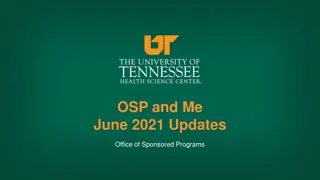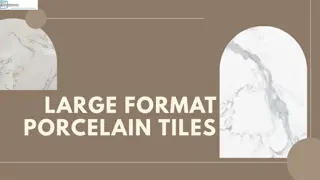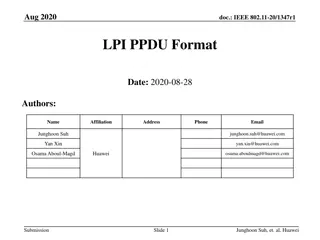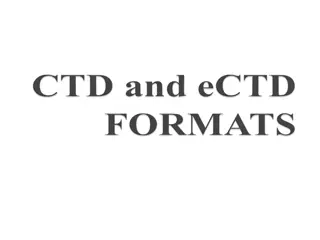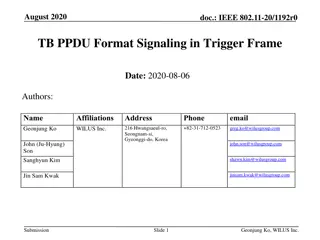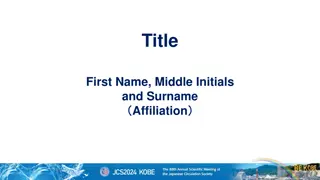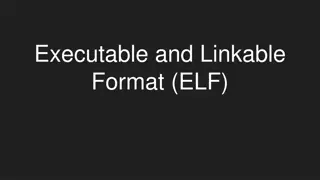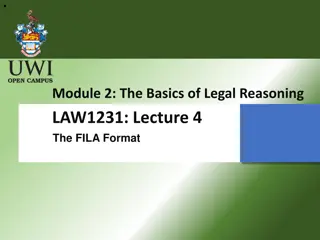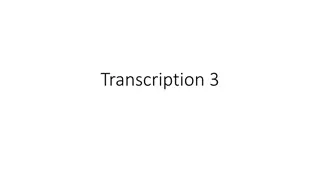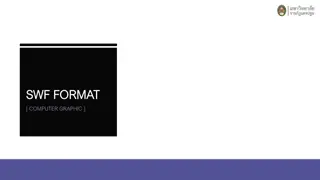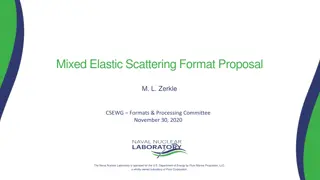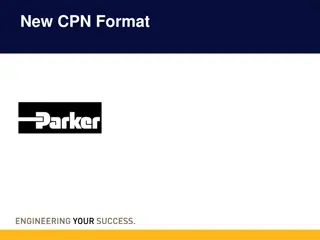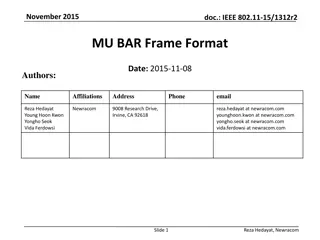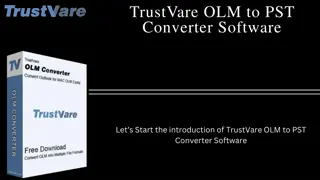
The Common Technical Document (CTD) Structure and Importance
Explore the Common Technical Document (CTD), a globally recognized format for pharmaceutical registration, and learn about its modules, significance, and role in regulatory approval processes. Discover why CTD is crucial, how it streamlines submissions, and its impact on drug development.
Download Presentation

Please find below an Image/Link to download the presentation.
The content on the website is provided AS IS for your information and personal use only. It may not be sold, licensed, or shared on other websites without obtaining consent from the author. If you encounter any issues during the download, it is possible that the publisher has removed the file from their server.
You are allowed to download the files provided on this website for personal or commercial use, subject to the condition that they are used lawfully. All files are the property of their respective owners.
The content on the website is provided AS IS for your information and personal use only. It may not be sold, licensed, or shared on other websites without obtaining consent from the author.
E N D
Presentation Transcript
CTD 1
WILL DISCUSS ABOUT:- What is CTD? Why CTD? Preparing and organizing the CTD (Modules) Conclusion References www.ngsmips.nitte.edu.in 2
ABBREVIATIONS CDSCO: Central Drugs Standard ControlOrganization CTD: Common Technical Document DCGI: Drug Controller General of India eCTD: Electronic Common TechnicalDocument FDA: Food and Drug Administration ICH: International Conference on Harmonisation IND: Investigational New Drug application NDA: New Drug Application USFDA: US Food and Drug Administration TGA: Therapeutic Goods Administration EMA: European Medicines Agency www.ngsmips.nitte.edu.in 3
WHAT IS CTD? Applicationformat CTD IS A JOINT EFFORT OF 3 REGULATORYAGENCIES: 1.European Medicines Agency (EMEA,Europe), 2.Food and Drug Administration (FDA, USA)and 3.Ministry of Health, Labour and Welfare (MHLW,Japan). The CTD is a set of specifications for a dossier for the registration of medicines (TGA) CTD is an internationally agreed well structured common format for the organization of the technical requirements that is to be submitted to the regulatory authority as an application for the registration of pharmaceuticals for human use in all three ICH regions (U.S.A., Europe and Japan). www.ngsmips.nitte.edu.in 4
WHY CTD? Hurdles put down by the 3 major regulatory authorities. Objective of ICH to prepare the CTD. Reduce the time and resources used to compile applications It will ease the preparation of electronic submissions. To facilitate simultaneous submission in three regions. To facilitate easier exchange of regulatory information and thereby ensure faster availability of new medicines. www.ngsmips.nitte.edu.in 5
MODULES OF CTD It is organized into:- Module 1: General Information Module 2: CTD summaries Module 3: Quality Module 4: Nonclinical study reports Module 5: Clinical study reports www.ngsmips.nitte.edu.in 6
MODULE 1 Administrative information and prescribing information. Document specific to each region. E.g. Application form Proposed label for use in the region www.ngsmips.nitte.edu.in 8
MODULE 1: GENERAL INFORMATION 1. 2. Covering letter & comprehensive table of contents Administrative information Brief introduction about the applicant company Duly filled and signed application in Form 44 and Treasury Challan Legal and Critical Documents such as Copy of Clinical Trial/BE., No Objection letters issued by CDSCO, Batch release certificate issued by National Regulatory Authorities E.g. For manufacture and marketing of finished products, in addition to the above mentioned docs, Copy of existing manufacturing license in Form 25 / 28. Copy ofForm-29 Certificate of Analysis Coordinates related to the application www.ngsmips.nitte.edu.in 9
1.3 General Information on Drug Product 5. Regulatory status in other countries 6. Domestic price of the drug followed in the countries of 7. A brief profile of the manufacturer s researchactivity 8.A brief profile of the manufacturer s business activity in domestic as well as global market 9. Information regarding involvement of experts, if any 10. Samples of drug product 11. Promotional materials www.ngsmips.nitte.edu.in 10
MODULE 2 - CTD SUMMARIES 1. 2. 3. 4. 5. 6. 7. Table of content of module 2 Introduction Quality overall summaries Non-clinical overview Clinical overview Non-clinical summaries Clinical summaries www.ngsmips.nitte.edu.in 11
2.3 QUALITY OVERALL SUMMARIES The Quality Overall Summary (QOS) is an outline of data presented in Module 3. Entire information present in Module 3 corresponding sections is not provided, but, provide brief information picked from relevant sections. 2.3.S Summary Of Drug Substance 2.3.P Summary Of Drug Product www.ngsmips.nitte.edu.in 12
2.4 NON-CLINICAL OVERVIEW 2.4.1 Introduction and GLP statement 2.4.2 Overview of the Non Clinical Testing Strategy 2.4.3 Pharmacology 2.4.4 Pharmacokinetics 2.4.5 Toxicology 2.4.6 Integrated Overview and Conclusions 2.4.7 List of Literature References Implications of nonclinical findings for the safe use of the pharmaceutical. www.ngsmips.nitte.edu.in 13
2.5 CLINICAL OVERVIEW Overview of analysis of the clinicaldata Provide a brief overview of the clinical findings Analyse the benefits and risks of the medicinal product in its intended use 2.5.1 Product Development Rationale 2.5.2 Overview ofBiopharmaceutics 2.5.3. Overview of ClinicalPharmacology 2.5.4 Overview ofEfficacy 2.5.5 Overview ofSafety 2.5.6 Benefits and Risks Conclusions 2.5.7 LiteratureReferences www.ngsmips.nitte.edu.in 14
2.6 NON-CLINICAL SUMMARIES Summary of pharmacokinetic, pharmacological and toxicology studies in-vivo/in-vitro, species, route and duration Appropriate age and gender related effects www.ngsmips.nitte.edu.in 15
2.7 CLINICAL SUMMARIES This section is intended to provide a detailed, factual summarization of all of the clinical information in the CTD. This includes: information provided in clinical study reports information obtained from any analyses for which full reports have been included in Module 5; and post-marketing data for products that have been marketed in other regions Synopses of Individual Studies www.ngsmips.nitte.edu.in 16
MODULE 3 - QUALITY The Quality section of the Common Technical Document (M4Q) provides a harmonised structure and format for presenting CMC (Chemistry, Manufacturing and Controls) information in a registrationdossier. Module 3 content Module Content 3.1 Module 3 table of contents 3.2 Body of data 3.3 Literature references www.ngsmips.nitte.edu.in 17
3.2 BODY OF DATA 3.2.S DRUGSUBSTANCE(S) 3.2.S.1 General information (name,manufacturer) 3.2.S.2 Manufacture of Drug Substance (name,manufacturer) 3.2.S.3 Characterization of DrugSubstance 3.2.S.4 Quality control of DrugSubstance 3.2.S.5 Reference Standards orMaterials 3.2.S.6 Container Closure System 3.2.S.7 Stability of DrugSubstance 3.2.P DRUG PRODUCT (NAME, DOSAGEFORM) 3.2.P.4 Control of Excipients 3.2.P.5 Control of DrugProduct www.ngsmips.nitte.edu.in 18
MODULE 4: NON-CLINICAL STUDY REPORTS Module 4 describes the format and organisation of the nonclinical (pharmaco-toxicological) data relevant to the application. 4.2 STUDY REPORTS 4.2.1 Pharmacology 4.2.2 Pharmacokinetics 4.2.3 Toxicology 4.3 literature references www.ngsmips.nitte.edu.in 19
MODULE 5: CLINICAL STUDY REPORTS Module 5 describes the format and organisation of the clinical data relevant to the application. 5.3.1 Reports of BiopharmaceuticalStudies 5.3.2 Reports of Studies Pertinent to Pharmacokinetics Using Human Biomaterials 5.3.3 Reports of Human Pharmacokinetic (PK)Studies 5.3.4 Reports of Human Pharmacodynamic (PD)Studies 5.3.5 Reports of Efficacy and SafetyStudies 5.3.6 Reports of Post-MarketingExperience 5.3.7 Case Report Forms and Individual PatientListings 5.4 literaturereferences www.ngsmips.nitte.edu.in 20
GUIDANCE FOR THE INDUSTRY Divided in 4 guidance document www.ngsmips.nitte.edu.in 21
CONCLUSION Whilst the realization of the CTD took many years, there is now a common format for the submission of Marketing Authorizations Applications across the three ICH regions - Europe, Japan and the USA. This should facilitate pharmaceutical companies to make simultaneous filings in the ICH regions as it will eliminate the extensive work previously required to convert, for example, a US dossier to an EU dossier and vice versa. www.ngsmips.nitte.edu.in 22
REFERENCES 1. Guidance for Industry on Preparation of Common Technical Document for Import / Manufacture And Marketing Approval Of New Drugs For Human Use (New Drug Application NDA) . Available at http://cdsco.nic.in/CTD_Guidance%20-Final.pdf Guideline M4: The Common Technical Document . Available at http://www.ich.org/products/ctd.html ICH Harmonised Tripartite Guideline: Organisation Of The Common Technical Document For The Registration Of Pharmaceuticals For Human Use M4 . Available at http://www.ich.org/fileadmin 2. 3. www.ngsmips.nitte.edu.in 23



